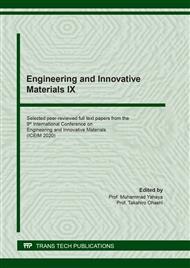[1]
Z.M. Huang, Y.Z. Zhang, M. Kotaki, S. Ramakrishna, A review on polymer nanofibers by electrospinning and their applications in nanocomposites, Compos. Sci. Technol., 63, 15 (2003) 2223–2253.
DOI: 10.1016/s0266-3538(03)00178-7
Google Scholar
[2]
A. M. Al-Enizi, M M. Zagho, A.A. Elzatahry, Polymer-based electrospun nanofibers for biomedical applications, Nanomaterials, 8, 4 (2018) p.1–22.
DOI: 10.3390/nano8040259
Google Scholar
[3]
K.P. Chellamani, P. Sundaramoorthy, T. Suresham, Wound dressing made out of Poly vinyl alcohol/chitosan nanomembranes, J. Acad. Indus. Res., 1, 6 (2012) 342-348.
Google Scholar
[4]
A. Aytimur and I. Uslu, Promising Materials for Wound Dressing: PVA/PAA/PVP electrospun nanofibers, Polym. - Plast. Technol. Eng., 53, 7 (2014) 655–660.
DOI: 10.1080/03602559.2013.874031
Google Scholar
[5]
S. Chen, H. Wang, Z. Jian, G. Fei, W. Qian, G. Luo, Z. Wang, H. Xia, Novel poly (vinyl alcohol)/chitosan/modified graphene oxide biocomposite for wound dressing application, Macromol. Biosci., 20, 3 (2020) 1–15.
DOI: 10.1002/mabi.201900385
Google Scholar
[6]
A. Cano, M. Cháfer, A. Chiralt, C. González-Martínez, Physical and antimicrobial properties of starch-PVA blend films as affected by the incorporation of natural antimicrobial agents, Foods, 5, 4 (2015) 1-17.
DOI: 10.3390/foods5010003
Google Scholar
[7]
M. Hajian, M. Mahmoodi, R. Imani, In vitro assessment of poly (vinyl alcohol) film incorporating aloe vera for potential application as a wound dressing, J. Macromol. Sci. Part B Phys., 56, 7 (2017) 435–450.
DOI: 10.1080/00222348.2017.1330183
Google Scholar
[8]
C. K. S. Pillai, W. Paul, C. P. Sharma, Chitin and chitosan polymers: Chemistry, solubility and fiber formation, Prog. Polym. Sci., 34, 7 (2009) 641–678.
DOI: 10.1016/j.progpolymsci.2009.04.001
Google Scholar
[9]
P. Chithra, G. B. Sajithlal, G. Chandrakasan, Influence of Aloe vera on the glycosaminoglycans in the matrix of healing dermal wounds in rats, J. Ethnopharmacol., 59, 3 (1998) 179–186.
DOI: 10.1016/s0378-8741(97)00112-8
Google Scholar
[10]
S.P. Miguel, M.P. Ribeiro, P. Coutinho, I.J. Correia, Electrospun polycaprolactone/aloe vera_chitosan nanofibrous asymmetric membranes aimed for wound healing applications. Polymers, 9, 5 (2017) 183-206.
DOI: 10.3390/polym9050183
Google Scholar
[11]
H. Sosiati, R.I. Ar-rasyid, P.A. Darmawan, Electrospinning of chitosan/poly (vinyl alcohol) nanofibrous membranes as an alternative wound, International Journal of Advances Mechanical and Civil Engineering, 7, 3 (2020) 29-34.
Google Scholar
[12]
W. Widowati, T. Mozef, C. Risdian, Y. Yellianty, Anticancer and free radical scavenging potency of Catharanthus roseus, Dendrophthoe petandra, Piper betle and Curcuma mangga extracts in breast cancer cell lines, Oxid. Antioxid. Med. Sci., 2, 2 (2013) 137–142.
DOI: 10.5455/oams.100413.or.038
Google Scholar
[13]
D. Pujimulyani, W.A. Yulianto, A. Setyowati, S. Arumwardana, R. Rizal, Antidiabetic and antioxidant potential of Curcuma mangga Val extract and fractions, Asian J. Agric. Biol., 6, 2 (2018) 162–168.
Google Scholar
[14]
B. Muchtaromah, E.S. Safitri, P.D. Fitriasari, J. Istiwandhani, Antibacterial activities of Curcuma mangga Val. extract in some solvents to Staphylococcus aureus and Escherichia coli, Proc. 3RD Int. Semin. Metall. Mater. Explor. New Innov. Metall. Mater., 2232 (2020) 030005-1–6.
DOI: 10.1063/5.0002490
Google Scholar
[15]
H. Sosiati, M.D. Rianto, A.W. Nugroho, Sudarisman, Fabrication by electrospinning technique and characterization of Curcuma Mangga Val reinforced PVA fibrous membranes, IOP Conf. Ser. Mater. Sci. Eng., 846 (2020) 012001-1–8.
DOI: 10.1088/1757-899x/846/1/012001
Google Scholar
[16]
D. Sundaramurthi, K.S. Vasanthan, P. Kuppan, U.M. Krishnan, and S. Sethuraman, Electrospun nanostructured chitosan-poly(vinyl alcohol) scaffolds: A biomimetic extracellular matrix as dermal substitute, Biomed. Mater., 7, 4 (2012) 1–12.
DOI: 10.1088/1748-6041/7/4/045005
Google Scholar
[17]
S. Agarwal and A. Greiner, On the way to clean and safe electrospinning-green electrospinning: Emulsion and suspension electrospinning, Polym. Adv. Technol., 22, 3 (2011) 372–378.
DOI: 10.1002/pat.1883
Google Scholar
[18]
X. Wei, Z. Xia, S.C. Wong, A. Baji, Modelling of mechanical properties of electrospun nanofibre network, Int. J. Exp. Comput. Biomech., 1, 1 (2009) 45–57.
DOI: 10.1504/ijecb.2009.022858
Google Scholar


